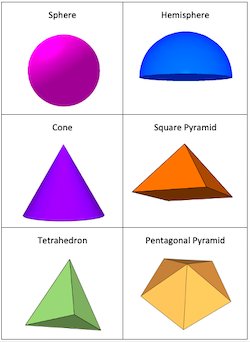Or search by topic
Number and algebra
Geometry and measure
Probability and statistics
Working mathematically
Advanced mathematics
For younger learners
Guess What?



This game, for two players, is based on the popular game 'Guess Who?'.

Each player needs:
- a printed copy of these sheets, cut up into individual cards, each one picturing a 3D shape
- a printed copy of this single sheet, showing all the 3D shapes
- a pencil.
The aim of the game is to guess which shape your partner has chosen before they guess the shape you have chosen.
How to play:
- Each player chooses one of the shapes on the single sheet and marks it somehow, for example using a pencil tick. (If the sheet is laminated, you could use a whiteboard pen.) This is the shape that your opponent is trying to guess.
- Each player lays out all their cards face-up in front of them.
- Player 1 asks player 2 a question to try to find out information about the shape player 2 has chosen. Player 2 can only answer yes or no in response.
- Based on player 2's answer, player 1 turns face-down any shape cards that they now know can't have been chosen by player 2.
- Player 2 now asks player 1 a question in a simillar way.
- The winner is whichever player finds out their opponent's shape first.
Try playing the game lots of times.
What questions are the 'best' to ask in order to find out your opponent's shape before they guess yours? Why are they good questions?
We would love to hear about the questions that work well for you!
You may also like
Add 3 Dice
Three dice are placed in a row. Find a way to turn each one so that the three numbers on top of the dice total the same as the three numbers on the front of the dice. Can you find all the ways to do this?
Online
A game for 2 players that can be played online. Players take it in turns to select a word from the 9 words given. The aim is to select all the occurrences of the same letter.

